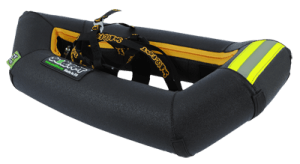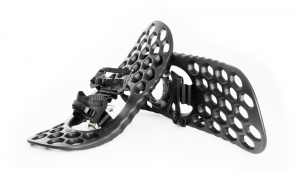Use
What should you watch for when shopping for your perfect pair of snowshoes? To start off with, it is important to know what kind of tours you are going to walk. If it is usually flat, long snowshoes with a high bearing capacity are best suited. In mountainous terrain, when you will be ascending and descending, slightly shorter or adjustable snowshoes with good iron points at the bottom are the best choice. For the steepest climbing work, special “climb snowshoes” are available. In this case, under your heel there is an extra raiser that can be folded up to support your heel on the steeper angled sections in the so-called ‘rising position’. This releaves a lot of pressure on your calf muscles.
A second factor is the weight of the user. The heavier the person, the more volume the snowshoe needs to have, normally it will result in a longer snowshoe. When buying, keep that extra 20 to 25 kilos you have on backpack tour in mind. Here too you can think of adjustable lengths, allowing you to extend the snowshoe in deeper snow or when carrying more weight.
Types
Nowadays there are three types of snowshoes. First of all, the classic frame snowshoe, where the load capacity is created by a tensioned strong plastic ‘sail’ in an aluminum frame.
In addition to the frame snowshoe, there is the fully hard plastic snowshoe. The full plastic variants are slightly lighter, and only these variants provide extensions for deep snow. Only these types of variants are available with a fixed heel.
 Recently the inflatable snowshoe of Small Foot has been added as an inflatable variant. These are developed by Small Foot and are gaining more and more terrain. The idea of inflatable snow shoes was born a few years ago.
Recently the inflatable snowshoe of Small Foot has been added as an inflatable variant. These are developed by Small Foot and are gaining more and more terrain. The idea of inflatable snow shoes was born a few years ago.
The inflatable snowshoes are compact and can be folded into two small packages. These make the snowshoes easy to stow away and allow them to be taken along easily during activities in the mountains.
While walking, you won’t be encumbered by the snowshoes and it does not require any special training or hassle. You walk in the same way as without snowshoes, but automagically you will have a lot more grip and less far sinkage in the snow. In principle, you always use ski poles when walking on snowshoes, just for balance, although you can often do without.
 Snowshoes make it easier to walk on and over deep snow. They spread the weight of the wearer over a larger surface so that your feet don’t sink into the snow.
Snowshoes make it easier to walk on and over deep snow. They spread the weight of the wearer over a larger surface so that your feet don’t sink into the snow.


